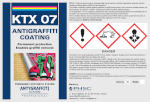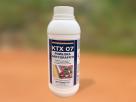The most universal anti-graffiti coating.
Through scientific research supported by numerous tests, we have developed a high-tech anti-graffiti paint marked KTX 07.
Principal characteristics and qualities of KTX 07 coating:
- a durable synthetic system allows repetitive removal of graffiti (up to 100 cycles);
- single-component preparation – does not require component mixing, does not generate losses caused by the curing of coating that was not used in a specific time – easy application;
- creates a transparent coating which facilitates graffiti removal;
- quick-drying, hardened by the air humidity;
- vapour permeable;
- removal of graffiti using only normal water or antigraffiti removers;
- anti-adhesive, creates an anti-poster effect – poster tapes and adhesives are more difficult to stick to the protected surface;
- UV-resistant, does not turn yellow;
- 20-year durability;
- high chemical resistance;
- very good application parameters: from -5 to +30°C;
- finishing variants: matt, gloss, RAL colour;
- environmentally friendly – does not require any aggressive preparations based on solvents or anti-graffiti acids;
- safe when removing graffiti paints – does not require any solvents harmful to the respiratory system, skin or eyes;
- applied using a roller, paintbrush, air spray or airless spray;
- may be applied on different substrates;
- Technical Approval No. IBDIM-KOT-2022/0841 by the Road and Bridge Research Institute;
- certified – construction mark B.
The KTX 07 anti-graffiti coating has the Technical Approval by the Road and Bridge Research Institute – it is an official state document authorising to use KTX 07 e.g. on engineering structures and in metro tubes.
Description of the preparation
KTX 07 is a unique, single component, colourlessly drying preparation based on synthetic organosilicon compounds, used for surface protection against graffiti, featuring anti-poster functionality with a strong anti-adhesive characteristics, which renders it difficult or even impossible to stick posters, stickers, and tapes with own adhesive layer. The preparation is fast-drying; it cures under the influence of air moisture and features very good adhesiveness. Treated surfaces are ideally protected against aerosol graffiti paints and most commercially available markers, ink, changeable weather conditions, bird droppings, dirt, acid rain, chewing gum, posters, stickers and adhesives; it also prevents water penetration and protects against hazardous substances. On its application, KTX 07 constitutes an anti-corrosive release liner that prevents paint coatings/pigments/adhesives and makes it easy to remove them from a coating surface. KTX 07 is a diffusion-open preparation with preservative properties and UV filters, thanks to which it retains the colour of the protected surface. Texture of protected surfaces remains intact. The preparation is available in three variants: gloss, matte/semi-matte, RAL colour.
National Technical Assessment:
Road and Bridge Research Institute No. IBDiM-KOT-2022/0841.
Technical data after application
Coating durability: up to 20 years. Graffiti removal: up to 100 cycles. Dried coating thickness: approx. 180 μm, depending on surface type and roughness. Full anti-graffiti protection is achieved after 24 hours at the drying temperature 22°C. The coating features anti-adhesive and anti-poster properties. The preparation also functions as a water-repellent and anti-corrosive layer and an elastomer with high formability, durability and resistance to adverse external factors: thermal, biological or chemical, UV radiation, alkali, corrosion, salt and ammonia solutions. KTX 07 is a durable system facilitating multiple removals of graffiti paints, without the need for coating restoration after graffiti removal.
Appearance on the substrate
On a substrate, the coating forms either matte/semi-matte or gloss effect (depending on the selected variant), which can be more or less visible depending on the type of substrate, amount and angle of sunlight. The substrate colour may become deeper, and in the case of faded colours, the coating improves/strengthens the colours. Some absorptive substrates, e.g. concrete, sandstone may become darker; in such a case, it is recommended to apply PX 07 primer, which prevents/minimises the darkening effect of the protected surface.
Areas of application
KTX 07 can be used on smooth as well as porous absorptive surfaces made of construction materials, such as: sand-lime bricks, fibre cement boards, ordinary bricks, clinker; mineral, acrylic, silicone, silicate plasters, concrete; natural stone, e.g. sandstone, granite, travertine; most paint coatings and hydrophobized substrates; as well as for sculptures, monuments, wood and for thermal insulation systems. It is suitable for use on non-absorptive surfaces, such as ceramics, some plastics, laminates, polyester, steel, galvanised steel, aluminum, and powder paint coatings. Due to a large variety of substrates, it is recommended to carry out initial testing before application to check reaction of the preparation with a substrate, define adhesiveness, the change in substrate colour shade, etc.
Compatibility with other painting systems
KTX 07 matte coating is compatible with most primers, water-repellents for paint coatings, including: polyurethane paint coatings, epoxy paint coatings, two-component acrylic systems, two-component polyurethane systems, anti-corrosive coatings, solvents, phthalic paint coatings and enamels, oil paint coatings, chlorinated rubber paint coatings, alkyd paint coatings, nitrocellulose paint coatings; and vinyl, acrylic silicate, and silicone dispersion-based paint coatings. An adhesion test should be carried out before applying the coating.
Application
After opening the container, stir all of the preparation thoroughly for approx. one minute with a mixer. After stirring, the preparation is ready for application. Do not dilute. Stirring is particularly essential in the case of 'matte' coating variant due to the added matte factor, which has to be well mixed in the entire volume of the packaging. Close the container after pouring over an adequate amount of the preparation. Contact with air will spur a slow curing effect of the coating, increasing its viscosity. The preparation is usable for several months after opening the container, as long as it is tightly closed and stored properly. In the case of a prolonged coating application, the preparation must be mixed repeatedly every couple of hours. Depending on weather conditions, the average application time is 6 hours at 20°C should the coating be poured into a container/tray; however, after 30 minutes, a skinning effect may gradually appear on the surface; it must be removed before further application.
KTX 07 coating application:
- MATTE variant: -5°C to +30°C,
- GLOSS variant: +10°C to +30°C,
- relative air humidity: up to 90%,
- the temperature of the substrate should be at least 3°C above the dew point temperature at that ambient temperature and humidity.
Amount of coating layers:
- the preparation should be applied in two layers.
The second layer should be applied approx. 3 hours after the first one has cured, at the drying temperature of 22°C. There are no time limits for application of the second layer or supplementary applications of the coating. In the case of a longer break between applications of the two layers, rinse the protected surface with water to remove dust and other atmospheric impurities.
Priming:
Anti-graffiti coatings in a permanent system and absorptive substrates may become darker and create the effect “wet concrete”. To improve the aesthetics of absorptive substrates, e.g., concrete, sandstone; architectural concrete use one or two layers of PX 07 primer. PX 07 primer causes reduction of the anti-graffiti coating wear and prevents/minimizes the darkening effect of the protected surface. Protect primed substrate from rain until the coating is applied. KTX 07 Anti-graffiti coating should be applied to the primed substrate after complete evaporation of water or dry the substrate, min. 1 hour. The substrates covered with paints and protective coatings are not primed. PX 07 primer application: +5°C to +30°C.
Drying time KTX 07 at 22°C:
- after 1 hour: dust-dry,
- after 2 hours: touch-dry, externally cured, no fingerprints left when touched,
- after 3 hours: cured,
- after 8 hours: complete curing.
Suitable weather conditions must be maintained throughout the entire coating drying period. Coating application in lower temperatures prolongs the drying time. Protect from rain for at least 3 hours after application. The complete curing of the coating is reached after 7 hours at 22°C. The coating should be applied precisely in order to cover all irregularities and cracks within the material structure. Failure to do apply the preparation precisely may limit the effectiveness of the coating and cause problems while removing graffiti paints. On a rough or porous surface, a uniform and sufficiently thick protective layer must be obtained. Make sure that no excessive coating should be applied on smooth surfaces; if streaks occur, distribute them on the substrate with a roller before they dry. The preparation can be used in ventilated rooms.
Application:
- lint free paint rollers,
- pneumatic/airless spraying method, nozzle 12 to 18.
Wear
The basic principle is to apply 2 layers of anti-graffiti coating.
Theoretical spread rate: 3 m²/L (333 ml/m²) up to 10 m²/L (100 ml/m²)
Theoretical spread rate is an approximate value defining the extreme consumption figures, which differ depending on the type of the protected substrate.
Absorptive surfaces, without texture:
3 m²/L (333 ml/m²) to 6 m²/L (167 ml/m²) jointly for two layers e.g., sandstone, concrete.
Low absorptive surfaces, without texture:
7 m²/L (143 ml/m²) up to 8 m²/L (125 ml/m²) jointly for two layers e.g., facade paint coatings.
Non-absorptive surfaces, smooth:
till 9 m²/L (111 ml/m²) jointly for two layers,
till 10 m²/L (100 ml/m²) one layer only for anti-poster protection e.g., steel, ceramics, granite, surfaces coated with powder paint coatings.
Practical spread rate: depends on individual cases and applications, including: conditions during application, methods of application, shape and roughness of protected surfaces, as well as substrate absorbability and application losses.
In order to increase the spread rate on absorptive surfaces, it is recommended to use a primer: PX 07: approx. 8.3 m²/L (120 ml/m²) jointly for two layers.
The Technical Approval required numerous tests of KTX 07, conducted in accordance with the following standards:
- PN-EN 1062-3:2008 Paints and varnishes – Coating materials and coating systems for exterior masonry and concrete – Part 3: Determination of liquid water permeability.
- PN-EN 1542:2000 Products and systems for the protection and repair of concrete structures – Test methods – Measurement of bond strength by pull-off.
- PN-EN 1767:2008 Products and systems for the protection and repair of concrete structures – Test methods – Infrared analysis.
- PN-EN ISO 2811-1:2012 Paints and varnishes – Determination of density – Part 1: Pycnometer method.
- PN-EN ISO 3219:2000 Plastics – Polymers/resins in the liquid state or as emulsions or dispersions – Determination of viscosity using a rotational viscometer with defined shear rate.
- PN-EN ISO 3251:2008 Paints, varnishes and plastics – Determination of non-volatile-matter content.
- PN-EN ISO 7783:2012 Paints and varnishes – Determination of water-vapour transmission properties – Cup method.
- PN-EN ISO 9001:2009 Quality management systems – Requirements.
- ASTM D6578 Standard Practice for Determination of Graffiti Resistance.
The following test procedure were used in the approval process:
- Test procedure of the Road and Bridge Research Institute: PB/TM-1/13 Assessment of protective coating (or lining) condition after freeze resistance testing.
The following reports of construction product tests were used in the approval procedure:
- Tests by the Road and Bridge Research Institute, Report of the Road and Bridge Research Institute 2016.





